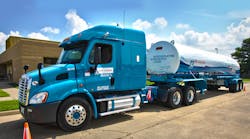Manager: David Paul
Title: Fleet operations manager
Fleet: Air Liquide USA, Houston, TX
Operation: 353 day cab, single- and dual-sleeper highway tractors hauling industrial gases
Problem:
Fleet safety is a big deal at Air Liquide USA LLC, so much so that the bulk carrier is investing big bucks to spec new trucks with a slew of safety systems that include collision prevention technology, lane departure warning, and blind-spot radar-powered sensors, to name just a few.
“We currently have 353 tractors in our fleet, and we replaced 133 in 2012 and another 145 at the end of 2013,” says David Paul, Air Liquide’s fleet operations manager.
He added that the company’s plan for its gaseous bulk-hauling fleet is to replace another 100 trucks this year. The goal is to turn over the trucks every 48 months. The average truck will have been driven 500,000 mi. in that time.
“This will help reduce our maintenance costs and maintain the reliability of our fleet to meet customer demand and expectations,” he explains. “This next purchase will replace all of our remaining 2009 fleet units so that all of our tractors will have the latest safety technology installed.”
The tractors—a mix of day cabs, single- and dual-sleeper cabs—are being equipped with advanced safety technologies. The question, though, is how does the addition of those systems affect maintenance?
Solution:
The first step is keeping Air Liquide’s field maintenance technicians up to date with the requirements of those new technologies, explains Paul. “We are using our vendors to provide on-site, hands-on training at our field locations and have our technicians attend our vendors’ local training at their facilities,” he explains. “We also have three fleet field maintenance supervisors who also attend all vendor-led training so they become subject matter experts to assist the field technicians.”
To better ensure that all technicians receive the same information, Paul adds that his fleet holds monthly maintenance conference calls to allow the techs to discuss any challenges or updates they may have.
He also expects Air Liquide’s fleet to experience some maintenance savings as a result of its investment in the safety systems. For example, its new trucks feature an air disc brake system that reduces stopping distance by 25% as compared to conventional brakes, while also reducing related repair costs. The addition of a stability control system that works in conjunction with the air brake system helps prevent rollovers by applying each wheel’s brakes in the correct sequence. It also reduces maintenance, Paul says.
“We expect a shorter stopping distance and longer brake wear with the disc brakes installed on all the new trucks,” he emphasizes.
“In conjunction with the air disc brakes, the Vorad [collision avoidance] system, the Meritor Wabco OnGuard brake assist application, and the Iteris [AutoVue] lane departure warning device all work together to help the driver avoid rear end and side impact collisions. [This helps] keep the driver’s attention focused on the task and reduces accident-related expenses,” Paul notes.
“All of our trucks are also equipped with Lytx DriveCam units that serve two purposes: first, to protect the driver in non-preventable events and second, to help us identify and correct driving behavior issues behind the wheel,” he adds, noting that maintaining a safe following distance is one such situation that can be corrected with the technology.
Convincing the drivers to accept all of this technology can be a daunting task, Paul explains. “But we make it clear that this new technology is there to assist the driver with the ability to return home to their families and loved ones in the same condition they came to work in,” he stresses. “We also share success stories where this technology has been instrumental in accident or incident avoidance or exonerating a driver in a non-preventable situation at our monthly sequential safety meetings.”



